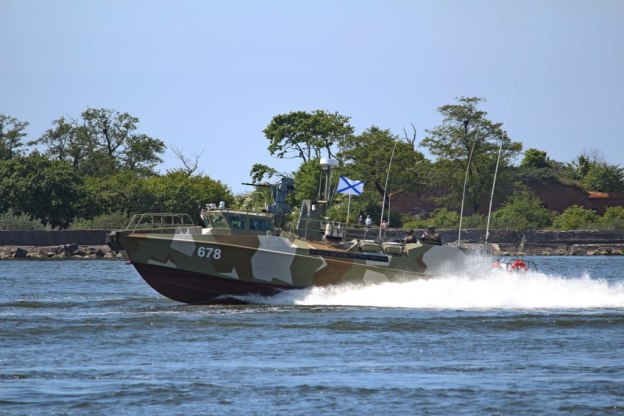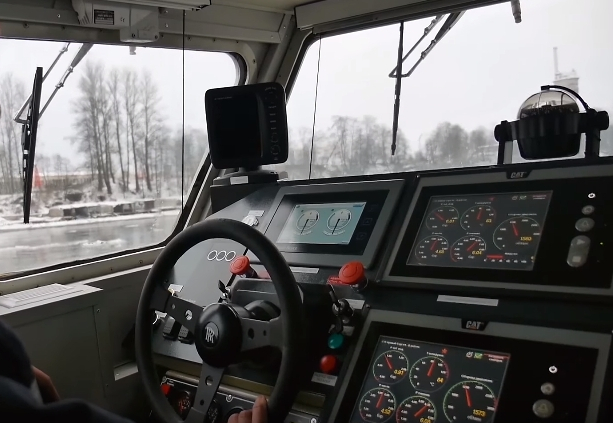The Raptor (Project 03160) high-speed patrol boats are designed and being built by Open JSC Pella Shipyard based in Leningrad, Russia. The boat can be deployed in a wide range of missions, including patrolling, search-and-rescue, anti-sabotage and anti-terrorism. It can transport up to 20 crew members of distressed ships or aircraft and has the ability to intercept and arrest light ships.
Project 03160 “Raptor”
The Pella Shipyard of St Petersburg, mainly known for their tug boats, last week officially launched the first series produced vessel of their new Project 03160 ‘Raptor’-class (ru. “Раптор”). This boat is rather interesting, if not for anything else, then at least because it bears a striking resemblance to a 30 year old Swedish design…
 Project 03160 “Raptor”. Picture from Pella Shipyard.
Project 03160 “Raptor”. Picture from Pella Shipyard.
The internet seems to differ whether the boat is in fact a licensed version of Dockstavarvets Combat Boat 90/Stridsbåt 90, or if it just “happens” to look like one. However, what is certain is that Dockstavarvet sold a number of its Interceptor Craft 16 M, a patrol craft based on the CB 90 concept, to the Russian border guards (FSB)[1]. The Raptor, however, seems to be based on the original CB 90 instead of the IC 16 M, and it is clearly stated that this time the customer is the Russian Navy, with at least four boats slated for the Black Sea Fleet.
Is the boat then a copy of the CB 90. If it is unlicensed, I believe the answer is ‘No’. The general layout certainly seems copied, but it is hardly revolutionary. Pella might have borrowed more than is considered “fair”, but the general characteristics of the CB 90 is conventional enough. To try and reverse engineer the details of the CB 90 would probably not have been worth the hustle. To begin with, Pella would have to send a number of engineers to a boat and measure it up, down to what size the bottom stringers are and how high the masthead light is, as well as document every little detail of the equipment. After this, the engineers would have to create the whole drawing package from scratch, after which they would have to adopt it to Pella’s materials and standards. What is the size of the Swedish chairs? Does Pella’s standard choice fit? What can be used instead? How is the Russian ballistic protection attached, compared to the original?
 Image bastion-karpenko.ru
Image bastion-karpenko.ru
Simply using a proven general layout, and starting an own design from there, is far faster than “true” reverse engineering. And I think speed is the issue here. Projecting boats from the keel up is a long process, even when it is a relatively small and straightforward one as the Raptor. Going through all the normal stages, with a preliminary round of tenders, choosing a winner, nailing down the details of the design, producing and testing a prototype, building a pre-production run, and then finally going into series production, usually takes at least a few years. Here it seems like the first steps have been skipped, and the project jumped straight into the detailed design phase. The result is a stop-gap vessel, built to expand on current capabilities (and numbers), rather than revolutionize them. This also fits the general trend of rapid expansion of the Russian armed forces. Edit 22:45 (GMT +2 DST) 25062014 corporalfrisk.com
The Russian Navy plans to procure a series of eight boats by 2015. Four of them were rolled-out in 2014, while the remaining four are scheduled to be launched in 2015. The boats will be operated by the Russian Navy’s Black Sea Fleet and will be based at the Leningrad Naval Base.
Orders and deliveries
The first Raptor patrol boat was launched in August 2013 and underwent builder’s sea trials in the same month. The boat was demonstrated to the Russian Navy in September.
The Russian Ministry of Defence awarded a contract to OJSC Pella to build and deliver a series of eight patrol boats for the Russian Navy in June 2014.
The first Raptor boat in the series was launched in June 2014 followed by the second in August 2014. The state acceptance board signed an acceptance act for a patrol boat in March 2015 and the boat was commissioned into the Russian Navy’s Black Sea Fleet in August 2015.
Completed
8 + 9 units
Ships
Pella Shipyard, Otradny
|
Name
|
Yard №
|
Laid Down
|
Launched
|
Commissioned
|
Note
|
|
P-274
|
№701
|
–
|
15.08.2013
|
5.03.2015
|
|
|
P-275
|
№702
|
–
|
17.06.2014
|
5.03.2015
|
|
|
P-276
|
№703
|
–
|
2014
|
5.03.2015
|
|
|
P-281
|
№704
|
–
|
2014
|
25.03.2015
|
|
|
P-280
|
№705
|
–
|
–
|
19.08.2015
|
from 7.10.2016 – P-280 Yunarmeets Baltiki |
|
P-344
|
№706
|
–
|
–
|
10.08.2015
|
|
|
P-845?
|
№707
|
–
|
2015
|
9.12.2015
|
|
|
P-838?
|
№708
|
–
|
14.11.2015
|
25.12.2015
|
|
|
P-415?
|
№709
|
–
|
14.12.2016
|
8.05.2017
|
|
|
P-413
|
№710
|
–
|
14.12.2016
|
05.2017
|
|
|
P-425?
|
№711
|
–
|
–
|
8.05.2017
|
|
|
P-
|
№712
|
–
|
30.05.2017
|
29.09.2017
|
|
|
P-
|
№713
|
–
|
24.08.2017
|
plan 2017
|
under construction |
|
P-
|
–
|
–
|
–
|
plan 2017
|
under construction |
|
P-
|
–
|
–
|
–
|
plan 2018
|
under construction |
|
P-
|
–
|
–
|
–
|
plan 2018
|
under construction |
|
P-
|
–
|
–
|
–
|
plan 2018
|
under construction |
Source russianships.info
Last two high-speed Raptor patrol boats delivered to Russian Navy: Here

Russian Defense Ministry Orders Additional Project 03160 High Speed Patrol Boats: Here
Excerpt
The Russian Defense Ministry and Pella Shipyard have signed a contract for over 10 Project 03160 Raptor-class patrol boats before 2018, according to the Gazeta.ru online news agency. Under the contract, the fast boats are to be delivered before year-end 2018. In addition, the manufacturer will build Project 16609 special harbor tugboats for the Russian Navy.
The Navy will conduct tests to evaluate the navigation and communications systems, life support systems, airborne weapons, as well as running and seaworthiness of the patrol boats before commissioning them into the Black Sea Fleet.
The crew of Raptor patrol boat will undergo a comprehensive and multi-level training at the Joint Training Centre of the Russian Navy in St Petersburg.
Design and features of Project 03160 patrol boat
The Project 03160 patrol boat accommodates two crew members and 22 personnel. It has maximum length of 17m, maximum width of 4m, a fixed height of 3.5m, and a depth of 0.9m. It has special cabins to house anti-terrorist groups, divers, lifeguards, inspection and rescue teams.
General characteristics – Project 03160
Schematics
Special boat – Project 03160 (var.1)
Special boat – Project 03160 (var.2)
Source russianships.info
Medical version
The boat is integrated with modern navigation systems, communications, radar and radios to provide high-navigability. The bridge is equipped with operator workstations and consoles for command and control.
Note: Some speculate that the Raptor have been deployed to Syria
Russian Assault Boats head to Syria: Here
 Image: hisutton.com
Image: hisutton.com
Weaponry
Combat module “Udovaya Kord” Remotely operated weapon station 14.5mm machine gun
 Remotely operated weapon station to hold a 14.5mm machine gun Image @bastion-karpenko.ru
Remotely operated weapon station to hold a 14.5mm machine gun Image @bastion-karpenko.ru
The boat is fitted with a remotely operated weapon station to hold a 14.5mm machine gun, as well as a gyro-stabilised, electro-optical module. The gun has a firing range of 2,000m and is used for defence against weapon systems and armoured targets. The electro-optical module provides target detection up to a range of 3,000m.
Version 2
Version 3
Specifications KPVT
Caliber: 14.5 mm
Cartridge: 14.5×114
Weight machine gun without: 52.5 kg
Overall length: 2000 mm
Barrel length: 1350 mm
Bullet muzzle velocity: 990-1000 m/sec
Effective rate of fire: 70-90 rds/min
Rate of fire: 600-650 rds/min
Sighting range: 2000 m
Ammunition belt capacity: 50 rds
Source gunrf.ru
2 x 7.62mm 6P41 Pecheneg machine gun
 7.62mm 6P41 Pecheneg machine gun Image @bastion-karpenko.ru
7.62mm 6P41 Pecheneg machine gun Image @bastion-karpenko.ru
7.62mm 6P41 Pecheneg machine gun is intended to engage hostile manpower, fire means and aerial targets.
The whole range of rifle cartridges is used to fire from the machine gun. The availability of gas regulator ensures the reliable operation of machine gun automatics in various operation conditions.
The high degree of commonality with the PKM machine gun and similar layout of automatics action ensure the reliability of the Pecheneg machine gun in any operating conditions.
The machine gun incorporates some design novelties aimed to increase the effectiveness of barrel cooling, which has allowed a spare barrel to be eliminated from the machine gun set.
The enhanced rigidity of the barrel, annihilation of its thermal deformation due to wind and actually the absence of thermal air flow from the heated barrel has made it possible to improve aiming conditions and increase accuracy of fire more than 2 times.
| Technical Characteristics | |
| Caliber, mm | 7.62 |
| Weight, kg | 8.2 |
| Rate of fire, rds/min. | 600…800 |
| Muzzle velocity, m/s | 825 |
| Aiming range, m | 1500 |
| Cartridge | 7.62×54R |
| Belt capacity, rds | 100 Х 200 |
| Overall dimensions, mm | 1200×115×213 |
| Operational temperature range, °C | ±50 |
Source zid.ru
Two bracket mounts are fitted at the stern to carry a 7.62mm 6P41 Pecheneg machine gun each. The gun has an aiming range of 1,500m and a rate-of-fire between 600 and 800 rounds a minute.
Protection features of Raptor patrol boat
Armour panels fitted on the hull provide level 5 and 5A protection against bullets. The 39mm-thick bulletproof glass windows offer ballistic protection for the occupants.
Propulsion and performance
 Image @bastion-karpenko.ru
Image @bastion-karpenko.ru
Powered by a 2,000hp engine, the Raptor patrol boat can reach a top speed of approximately 50k. It can execute missions in a radius of 100 miles (160km) from its operating base.
The boat is capable of operating in coastal waters, estuaries and straits both during day and at night.
Caterpillar C18 diesels
Pella has not given out their engine of choice on their homepage, but a secondary source of uncertain value gives the engines as Caterpillar C18’s. This seems logical, as several of Pella’s tugs have been fitted with Caterpillar diesels. The C18 has a dryweight of 1950 kg, or 400 kg more weight for the pair of marine diesels.
 Caterpillar C-18 Marine Engine
Caterpillar C-18 Marine Engine
 The stern with the water jets of the Raptor. Source: Pella JSC.
The stern with the water jets of the Raptor. Source: Pella JSC.
I have not found the model or manufacturer of the waterjets of the Raptor stated anywhere. However, if one looks closely at the drawings provided by Pella, it becomes very clear.
That, my dear friends, is a Rolls-Royce Kamewa A3-series water jet, most probably of the 40A3-model. Unlike the axial-flow FF-series, the A3 provides a hybrid-flow design, giving higher performance. However, another major difference is in the material.
Rolls-Royce Kamewa A3-series water jet
 Roll-Royce Kamewa A3 series waterjet @maritimejournal.com
Roll-Royce Kamewa A3 series waterjet @maritimejournal.com
Where the FF-series is made of aluminium, the A3 is of an all-steel construction. This raises the dryweight to 850 kg apiece, with an entrained water volume of 186 litres/kg. In total, a simplified calculation of the weight of the drive package (not counting liquids, turbocharger, transmission, shaftes, …) of the Raptor gives a total weight of 5970 kg, with the corresponding value of the CB 90 being 4755 kg. This is a 25% increase in the mass of the drive train (compared to a total increase in displacement of 28%). In fact, the increase in weight of the engine and water jet accounts for roughly 24% of the total increase in displacement. Source corporalfrisk.com
Main material source naval-technology.com
| Displacement (tons): | |
| Standard: | – |
| Full load: | 23 |
| Dimensions (m): | |
| Length: | 16,7 |
| Beam: | 4 |
| Draft: | 0,85 |
| Speed (knots): | 48 |
| Range: | 300 mni |
| Autonomy (days): | – |
| Propulsion: | 2×1150 hp Caterpillar C18 diesels, 2 pump-jets |
| Armament: | 1×1 14,5 mm (not on №706) 2×1 7,62 mm 6P41 «Pecheneg» (not on №706) |
| Electronics: | “Nautilus” navigation radar |
| Complement: | 2+22 |
Source russianships.info
Updated Apr 13, 2018












Measure everything??? How 20th Century… all the Russians would need to do is steal the CAD-CAM and parts files, then proceed from there. Is it a perfect copy, nope. But it is a concept copy.
LikeLike